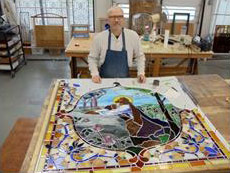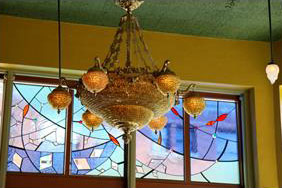Stained Glass, Part II
Last week, we read about prized Povey stained glass, two originals of which hang at O’Kanes in Bend. Povey Brothers glass was all the rage in the early 1900s, and is still highly sought-after today.
This week, we have a look at a contemporary stained glass artist, David Schlicker. He has been in business as the founder, owner and lead designer of his studio on Division St. in SE Portland for more than 35 years.
His work is found in churches, private homes and businesses (including McMenamins) throughout the Pacific NW, on the East Coast and in such far-flung places as Egypt.
 Walk into the dimly lit interior of Rock Creek Tavern in Hillsboro, and as your eyes adjust, you’ll be stunned by the brilliance of the stained-glass pastoral mural to the right of the entrance, depicting Bill Fuegy and the blacksmith shop that he later tranformed into the landmark tavern.
Walk into the dimly lit interior of Rock Creek Tavern in Hillsboro, and as your eyes adjust, you’ll be stunned by the brilliance of the stained-glass pastoral mural to the right of the entrance, depicting Bill Fuegy and the blacksmith shop that he later tranformed into the landmark tavern.
Take in the majesty of the kaleidoscope-like array of glass that Dave blended together to recreate a long-lost exterior canopy above the entry to the Olympic Club Hotel, glowing with an inviting warmth. He also recreated stunning new light shades based on the tulip design of the Oly Club Saloon’s original 1913 Tiffany glass shades. Several of these now bathe Edgefield’s Black Rabbit Restaurant in an elegant light.
Gaze at the serene images of St. Francis and Fr. Luke at Old St. Francis School in Bend, not to mention the glorious sun and moon skylights that filter colors into the soaking pool.
Many such remarkable examples of Dave’s stained glass talents can be found throughout McMenamins.
While much of Schlicker’s work is traditional in the “stained-glass sense” – gorgeous church windows, Povey-esque craftsman fixtures and more – the artist has also done some atypical organic pieces for McMenamins, the most striking of which can be found in the Zeus Café (renamed Hal’s Café in 2023) at the Crystal Hotel in downtown Portland.
 Walking into Zeus Café, the first thing you might notice is the light flooding in through the huge glass windows. Bordered on one side by Burnside St. and Stark on the other, the windows give the place an open airiness. After a moment, you might notice the prisms and lights dancing across the floor and tables, scattered via the multiple stained-glass panels that circle around the entire room. (One panel is shown here, behind the chandelier.)
Walking into Zeus Café, the first thing you might notice is the light flooding in through the huge glass windows. Bordered on one side by Burnside St. and Stark on the other, the windows give the place an open airiness. After a moment, you might notice the prisms and lights dancing across the floor and tables, scattered via the multiple stained-glass panels that circle around the entire room. (One panel is shown here, behind the chandelier.)
This custom-designed work by Schlicker is actually a visual representation of the Grateful Dead’s “Dark Star,” a song released in 1968 that was long considered one of their most anticipated numbers, often with the group using it as a vehicle for musical improvisation sessions that extended beyond the original structure of the song. The Rock and Roll Hall of Fame called “Dark Star” one of 500 Songs that Shaped Rock and Roll and it was also ranked at number 57 on Rolling Stone’s 100 Greatest Guitar Songs of All Time.
Incredibly, Schlicker has brought into his artistic composition a visual expression of the classic song’s melody. Starting from the window in the northwest corner of the café, one can follow the song’s progression note-by-note, around the room, interspersed with amorphous bursts of color and design representing the song’s points of improvisation. What the Grateful Dead captured musically, Dave performed in glass, and here, in an interview with Charles Reich, Jerry Garcia put to words:
Reich: Well then if we wanted to talk about “Dark Star,” uh, could you say anything about where it comes from?
Garcia: You gotta remember that you and I are talking about two different “Dark Stars.” You’re talking about the “Dark Star” which you have heard formalized on a record, and I’m talking about the “Dark Star” which I have heard in each performance as a completely improvised piece over a long period of time. So I have a long continuum of “Dark Star” which range in character from each other to real different extremes. “Dark Star” has meant, while I’m playing it, almost as many things as I can sit here and imagine, so all I can do is talk about “Dark Star” as a playing experience.
Reich: Well, yeah, talk about it a little.
Garcia: I can’t. It talks about itself.
So, Schlicker’s brilliantly rendered glass representation of this Dead song, along with the murals, windows and light fixtures found throughout our pubs and hotels, just are what they are – beautiful, color-throwing pieces of art meant to stimulate the senses, a different interpretation arising every time you see them.
